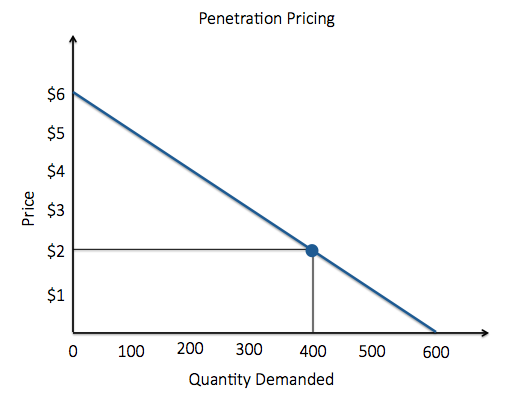11.6: Reading- Penetration Pricing
- Page ID
- 48140
What Is Penetration Pricing?
Penetration pricing is a pricing strategy in which the price of a product is initially set low to rapidly reach a wide fraction of the market and initiate word of mouth.[1] The strategy works on the assumption that customers will switch to the new product because of the lower price. Penetration pricing is most commonly associated with marketing objectives of enlarging market share and exploiting economies of scale or experience.
Returning to our economic model, below, you can see that penetration pricing focuses at the bottom of the demand curve. If the initial price is set low, at $2, for instance, the quantity demanded will be high: 400 units.

Penetration pricing offers a lower price in order to draw in a higher demand from consumers.
Why Might Penetration Pricing Make Sense?
Like skim pricing, penetration pricing shows an awareness of the dynamics in the product life cycle. The advantages of penetration pricing to the firm are the following:
- It can result in fast diffusion and adoption across the product life cycle. The strategy can achieve high market penetration rates quickly, taking competitors by surprise and not giving them time to react.
- It can create goodwill among the Innovators and Early Adopters, which can generate more demand via word of mouth.
- It establishes cost-control and cost-reduction pressures from the start, leading to greater efficiency.
- It discourages the entry of competitors.
- It can generate high stock turnover throughout the distribution channel, which creates important enthusiasm and support in the channel.
The main disadvantage of penetration pricing is that it establishes long-term price expectations for the product and image preconceptions for the brand and company. Both can make it difficult to raise prices later. Another potential disadvantage is that the low profit margins may not be sustainable long enough for the strategy to be effective.
- J Dean (1976). "Pricing Policies for New Products." Harvard Business Review 54 (6): 141–153. ↵
Contributors and Attributions
- Revision and Adaptation. Provided by: Lumen Learning. License: CC BY-SA: Attribution-ShareAlike
- Penetration Pricing. Provided by: Wikipedia. Located at: https://en.Wikipedia.org/wiki/Penetration_pricing#cite_note-4. License: CC BY-SA: Attribution-ShareAlike
- Mallards Feeding. Authored by: Yankech Gary. Located at: https://www.flickr.com/photos/49663413@N08/6965646827/. License: CC BY-ND: Attribution-NoDerivatives



